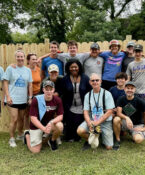Tourniquet training pays off in emergency for HSC PA alum
By Alex Branch
Emily Holloway (PA ’20) has sewn shut plenty of open wounds at the rural urgent care center where she works in on the East Coast. But she hadn’t encountered anything like the bleeding man who rushed through the clinic’s doors recently.
He had sliced his arm open on broken glass. His hand and his shirt were soaked with blood. The clinic doctor quickly suspected it was arterial bleeding — the most severe kind.
The patient needed ambulance transport to the nearest emergency room. The problem: The nearest emergency room was 20 minutes away.
“We called the ambulance but he was losing so much blood,” said Holloway, a graduate of the HSC Physician Assistant Studies Program. “We had to control the bleeding while we waited for this to have a good outcome.”
The medical team surveyed their equipment. They could use a flimsy blue band used for patient blood draws or a blood pressure cuff as a tourniquet.
“Neither was ideal,” Holloway said. “So I reached for my backpack.”
That’s because about two years ago as an HSC student Holloway received a tourniquet and training to tie one as part of the PA school’s curriculum. The training was a part of Stop the Bleed, a federal national awareness campaign to prevent bleeding deaths.
The training was incorporated into the PA curriculum by Dr. Jeffrey Mott, Assistant Professor, who previously served in the U.S. Army and taught military medical personnel to apply tourniquets and other life-saving techniques before they deployed to combat.
A $25,000 grant from North Central Texas Trauma Regional Advisory Council helped HSC purchase medical equipment, including tourniquets for students, faculty and campus police.
For more than two years, Holloway kept her tourniquet in her backpack for an emergency. She was in one now.
“We were trained how to make tourniquets out of whatever fabric we can find but it was so helpful to already have a good tourniquet ready to use,” she said. “I put the tourniquet on the patient and even showed the excellent doctor I work with how to tie it.”
“Tourniquet training is not something a lot of health providers learn in school so this skill sets HSC graduates apart,” she said.
The tourniquet controlled the bleeding until the ambulance arrived. Holloway said she wasn’t able to learn the ultimate outcome but was confident that the man would recover.
“I’m so thankful my school prepared me for this,” she said.





Social media